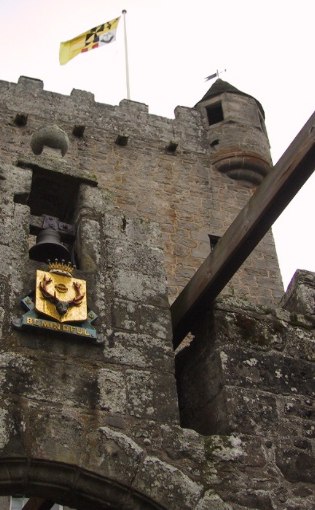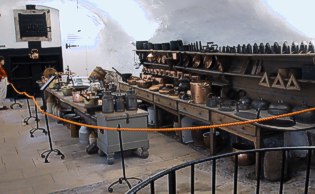
 | ||
Cawdor Castle
After Findhorn, Rochelle and I drove over to Cawdor Castle by way of Forres, site of a standing monument called "Suenos Stone" that caused me to do some serious thinking about time and communication. The name "Suenos Stone" has no particular relevance -- time out of mind, someone named Sueno dug this stone out of a field. "Chester's Fort" is named for a similar reason. | ||
 Suenos Stone |
What's interesting about Suenos Stone is that it can be positively dated to some time in the 10th century. It is intricately carved and very large, standing more than 18 feet tall. (It now lives in a glass enclosure because acid rain and exhaust from the nearby highway were causing it to decay.) On its front, there's a "circle cross" -- what we call a Celtic Cross -- which shows that its makers were of the Christian persuasion. All the other symbols -- and there are very many -- are pictish pictograms telling what is obviously a vivid story involving slavery, bloodshed, warfare, and strife. The image to the left is of the back of the stone.
Historians are able to offer not one, but three possible interpretations of the stone's message, all contradictory, and involving three major events known to have taken place in the area in between 923 and 966. Unfortunately, they are unable to whittle their interpretations down to one. |
|
Now I find this fascinating -- an obviously important message from scarcely a millennium ago ... and we can't read it! And yet we propose to encase radioactive materials with a half-life of 22,500 years in carefully marked containers that will be readable by folks in, say, forty millennia. What if their historians conclude that our message is "yummy stuff -- open container and spread liberally on your food"? |
Well, onward we went ... to a nearby, much better documented, product of a later time: the 14th century, the seat of the Thanes of Cawdor, of Shakespearian fame.
It was just by happy accident that we chose this particular castle to visit, because it has been inhabited by a long line of quirky people -- 26 Thanes to date. The late Thane, also Sixth Earl of Cawdor, has explained the family home with wit and depth, so I'm going to let him explain. Over to you, Earl...
Cawdor was described by Robin Fedden as having a quality where "distant past and present rarely seem to meet with so little loss." An earlier writer thought that the components of the house "all conspire to excite the most gloomy inquiry in the mind." A man of few words called the house "very effective." |
 Castle gate, drawbridge, and tower |
 The stream beside the Castle |
The exact date of the oldest building is unknown. Architectural historians, relying on the quality of the stonework, date it to the last quarter of the 14th century, about 1380. [A dead holly tree that the tower was built around whilst it lived, can be tree-ring dated to having expired in 1372, when presumably it was cut off from the light. Remnants of the tree may still be seen within a ground-floor room.] Literary academics, who prefer the written word, support the date of the building licence – 1454. The tower dominated the local farmlands and forests – otherwise the building had no strategic nor military significance. Its purpose was simply to provide a strong, family home. "I shall build me such a house as theives will need to knock ere they enter," was the vow of one Aberdeenshire gentleman, Patrick Forbes of Castle Corse, fed up with plunderings. And the tower of Cawdor was just such a gesture of optimism and defiance. Architectural decoration was minimal. Apart from the gargoyle waterspouts and roll-mounds for the window-jambs, there is no frivolity nor ostentation in the design. A sharp dagger needs no ribbon. |
| "Living in a place like this in those days," remarked a visitor, "must have been dreadful. Smelly, dark, draughty, uncomfortable, and either dangerous or dull." "Yes," said the companion, "but different to being dead." |
| The Yellow Room The layout of this room is peculiar. The fireplace is hopelessly off-centre, the windows are irregular, the wall are out of square, the plaster is floated directly onto the rough masonry, the bold Restoration cortnice is uneven and yet, for all that, it makes a rather charming sitting-room. The handsome lady in the saucy brown hat is Mrs. Jane Philips, affectionately nicknamed 'Aunt Glum', painted by Enouch Seeman. The pastel drawings are of John Campbell of Cawdor(1717), and his wife Mary. The 18th century cupboard conceals a television set. The battered oak armchair is Charles I. Over the mantelpiece hangs a portrait of John Vaughan of Golden Grove, in Wales, by William Williams. |
 The Yellow Room
On either side of the fireplace are paintings of cottages; the one on the left is by John Varley, and the one on the right by Sir William Beechey stands on an easel, which is really an old fire-screen, in the corner of the room. Over the arched doorway is a cartoon in the oils by Henry Bunbury of the artist and the 1st Lord Cawdor as peasants shifting, er, manure. |

|
The Dining Room The larger tapestries are cartoons of Miguel de Cervantes' story of Don Quixote are most extraordinary in their grotesque style. The maker and designer are not known for certain. Experts, as ever, disagree: one theory is that the panels are Spanish of the late 17th century, but recent research suggests that they are the work (c.1680) of James Bridges who is thought to have succeeded, and used the same cartoons as, Francis Poyntz of Hatton Garden in London- 'Yeoman arrasworker to the Great Wardrobe'. Various scenes from the book are easily recognisable- the Knight of the Woeful Countenance trying to bait the tame lion into fighting; tilting at the windmills mounted on his scrawny steed, Rocinante; being knighted by the innkeeper. |

detail from the "Don Quixote Tapestry" |
The mantlepiece commemorates the marriage in 1510 between Sir John Campbell of Argyll and Muriel Calder of Cawdor. The allegorical design and the inscription in dog Latin have never been satisfactorily explained or translated, all of which is highly satisfactory. The writing may mean 'In the morning, remember your creators'. Or it may mean something quite else, like "If you stay too long in the evening, you will remember it in the morning." |
| The Old Kitchen In stark contrast to the last room you visited, this kitchen was in active use between 1640 and 1938. It is a beautiful room rather than every housewife's dream. The amazing cooking range is 19th century, and the amazing contraption above is the gearing for a spit: a rotator (one of the few English words, Madam, that is a palindrome) was moved by a fan in the flue. In 1760 it was the very latest thing and was, at least in theory, automatic because the hotter the fire became, the quicker the meat turned. The cabinet is an old ice-box, and there are flat-irons, smoothing-irons, a clothes Peggie, a trivet, a warming-pan, a circular knife-grinder, butter-hands, a Lazy Susan, a pestle and mortar, a bucket-yoke, a butter-churn, a cusie lamp, earthenware jars and other priceless junk, some of it defying identification. |
 The Old Kitchen
The kitchen table was constructed in the room. |
|
Victoriana [There is a] picture by Sir Edwin Landseer of Sarah Mary Cawdor's dog, commissioned by Queen Victoria who had the terrier "kidnapped" so that it could be painted, secretly, as a surprise present. Sarah Mary was somewhat of a favorite Lady-in-Waiting to Her Majesty, and was allowed to take Scotty with her while attending the Queen. Later, the painting was given to young Alister Campbell, a grey sheep of the family, who flogged it. It was bought back again by a bevy of furious aunts. material by Hugh Campbell, Sixth Earl of Cawdor |
 |
One of the most striking aspects of Cawdor is the forest along the stream, filled with trees gathered over centuries from all over the world. We found both of our redwoods, gigantea and sempervirens. But the native broadleaf species are the most luxuriant and at-home. We also enjoyed the two formal gardens. Unfortunately, we were not able to walk the maze, because it's a shallow-rooted holly maze and cannot withstand the pressure of the hundreds of visitors that come to Cawdor.
Tea was served in the lovely tea room. Needless to say, the tour ended in not one, but THREE gift shops. Well, yes, another business, but shamelessly entertaining! |
 The formal Flower Garden |
 The Walled Garden |
|
|
updated 22 July 2001 : 7:18 Caspar (Pacific) time this site generated with 100% recycled electrons! send website feedback to the Solarnet webster |
© 2001-2002 by Caspar Institute. All Rights Reserved. | |